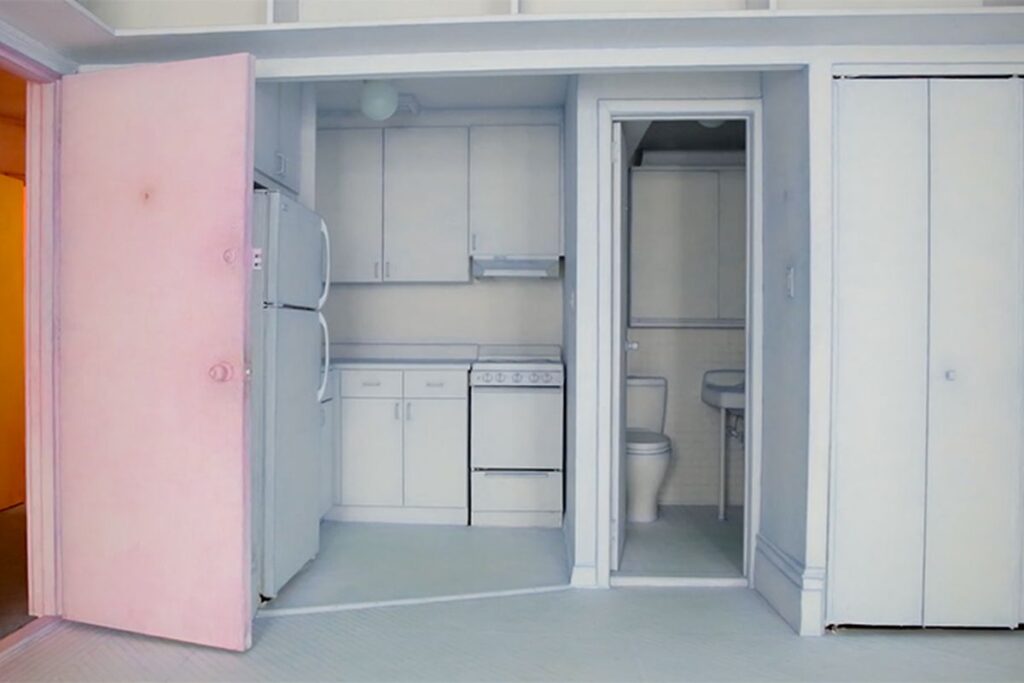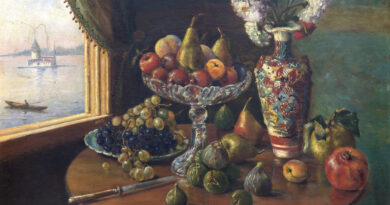touching bygone times and memories: rubbing/loving project-2016
BY MÜMTAZ SAĞLAM
the Rubbing/Loving Project, which entails a relentless pursuit of traces and remnants of experience through the frottage and rubbings of an emotionally-charged, paper-covered private stage of life; is actually structured on personal, psychological and political frameworks of reference. As private forms of relationship with the structure, rubbing and loving express acts of emotional sentiment and remembrance by rendering layers, textures and fragile personal history visible on worn-out paper surfaces…

Do Ho Suh, Rubbing/Loving Project: Unit 2, 348 West 22nd Street, Apartment A, New York, NY 10011, USA, 2016. [https://archive.curbed.com/2016/12/12/13927584/do-ho-suh-art-nyc-apartment-rubbing]
The focus of Do Ho Suh’s early work is cultural conflict and change. The artist renders these issues visible in the present project, that gains new meaning through bio-political reasons and allusions.[i] The work, entitled the Rubbing/Loving Project, is a holistic installation that renders a radical difference of lifestyles, and the entailing ideas with an intervention focused on a single location.[ii] By covering a building he has lived in for a considerable time – and therefore developed an emotional attachment to – with paper, the artist once again embarks on a chase of psychic associations derived from the contrast between decorative care and empty spaces. The monochrome paper covering, subtly different in every floor of the building; attempts to depict the dramatic and surreal character of the space, its soul and its death.
Within this work, Suh’s acts of covering a New York building with paper and his act of transferring textures of the said building onto paper with a personal frottage technique are acts of preservation and documentation that replace his usual experience of transparent spaces with a new, hybrid and transient sense of location.[iii] Based on a pursuit of clues to illuminate the mystery and the memory of a certain locale; the work stands out as an attempt to create a conceptual, creative stance. By creating a space that reveals and unites traces and leftover stories on the home/building; Do Ho Suh wants to touch the passage of time with the rubbing traces captured on the paper sheets that cover all available surfaces ini the installation. The frottage, or rubbing technique employed by the artist insistently expresses a sense of contact – both in terms of culture and in terms of artistic thought. It also renders the sense of atmosphere that permeates different floors and rooms deeper, more emotionally charged, and also a little unsettling.
an aura shaped by bio-political necessities
By rubbing and wearing down the paper surface, Do Ho Suh intentionally renders it unearthly; and by freezing the passage of time, tries to approach the sense of a stage for the death of a location. For this reason this technique, conducted in narrow interiors, takes on a different meaning from Suh’s usual installations based on transparent polyester home/building setups. He reveals a de-objectifying new psychological outlook that covers the spirit of a space instead of its actual self. This outlook, this novel field of vision, is also a new reality that produces new relations of observation between the covered or occluded objects, and the subject space itself… Thus, this practice of covering and frottage gains importance as a novel possibility of expression that resembles a camouflage of public space; engendered by bio-political references, metaphorically freezing time, and masking a spiritual atmosphere.
Seen inside the house, Do Ho Suh’s frottage effect actually creates a three-dimensional interior landscape. With loving strokes and rubbing, the work captures and preserves all textures present in the house/room, be they metal, wood or ceramic. Converting memories into aspects of location-based psychology or archaeology, the holistic image – or the visual field – that Suh forms with his ritual of rubbing, frottage and scraping; gains new meaning in the present age of migrations and border politics as an impression of average lives, as a temporary form of temporary documentation and ghostly imagery. The psychic meanings imparted onto the paper constitute the principal dynamic that questions a complicated network of relationships between the home/room structure and the viewer in terms of physical proximity and a stage of display.
The resulting performative experience that emerges in this building, enriched with details that result from the paper-cladding process; is an attempt to conceptualize the issue at hand with a representational performance with paper and pencils. Thus, the act of creative abrasion, which imbues the locale with a ghostly visual aspect, helps layer and include the melange of lives, memories and secrets in this conceptual stage of display.
fixing down traces and the remnants of experience
Do Ho Suh truly places his alienated, abstracted, rarefied interpretations of structure, building and home within a subjective gaze and psychological topology of concepts. Content with merely visualizing, the artist makes no attempts to tell stories. With his layered, detailed location-based experience; Suh’s aim is to open up new conceptual vistas that focus on issues of otherness, cultural difference, and change of identities. The method with which he constructs these experiences is structured with an emphasis on otherness, and houses discreet meanings of hybrid experiences.
Nevertheless, Suh’s gaze, which embodies a fragile emotionality, distances itself from the viewer by creating emotions of cold, emotional objectification; and a sense of distance. But the powerful narrative, which the viewer can literally walk around in, and which bears testament to Suh’s inner world; beckons us to accept it in a holistic, permanent paradigm that draws on its immaterial, conceptual and formal strengths – rather than its flourishing display of material aesthetics.
In the end, the Rubbing/Loving Project, which entails a relentless pursuit of traces and remnants of experience through the frottage and rubbings of an emotionally-charged, paper-covered private stage of life; is actually structured on personal, psychological and political frameworks of reference. As private forms of relationship with the structure, rubbing and loving express acts of emotional sentiment and remembrance by rendering layers, textures and fragile personal history visible on worn-out paper surfaces… (Translated by C.M. Kösemen)
Mümtaz Sağlam, Copyright © 2022 / All Rights Reserved.
see. https://saglamart.com/do-ho-suh-the-home-as-a-symbolic-locale-of-the-diasporic-experience
[i] Do Ho Suh (b. 1962, Seoul, Korea; lives and works in London, United Kingdom) works across various media, creating drawings, film, and sculptural works that confront questions of home, physical space, displacement, memory, individuality, and collectivity. Suh is best known for his fabric sculptures that reconstruct to scale his former homes in Korea, Rhode Island, Berlin, London, and New York. Suh is interested in the malleability of space in both its physical and metaphorical forms, and examines how the body relates to, inhabits, and interacts with that space. He is particularly interested in domestic space and the way the concept of home can be articulated through architecture that has a specific location, form, and history. For Suh, the spaces we inhabit also contain psychological energy, and in his work he makes visible those markers of memories, personal experiences, and a sense of security, regardless of geographic location. [https://www.lehmannmaupin.com/artists/do-ho-suh/biography]
[ii] Between 2012 and 2016, Do Ho Suh carried out a comprehensive study called the Rubbing/Loving Project in a three-storey building in New York, where he lived for nearly twenty years, used the ground floor as a home and workshop, and was sold and evacuated due to the death of the owners. Covering all interior surfaces of the building with adhesive paper; The artist, who fixes the traces and textures he has taken with colored graphite pencils by rubbing and rubbing, thus wants to touch, remember, love and feel the passing time. The project is presented through the following information: Do Ho Suh, Rubbing/Loving Project: Unit 2, 348 West 22nd Street, Apartment A, New York, NY 10011, USA, 2014
[iii] frottage: a thin material such as paper is placed/coated on a textured surface and can be made with graphite, mummy or colored pencils, etc. It is the process of rubbing the surface with something and removing the trace of the surface.



